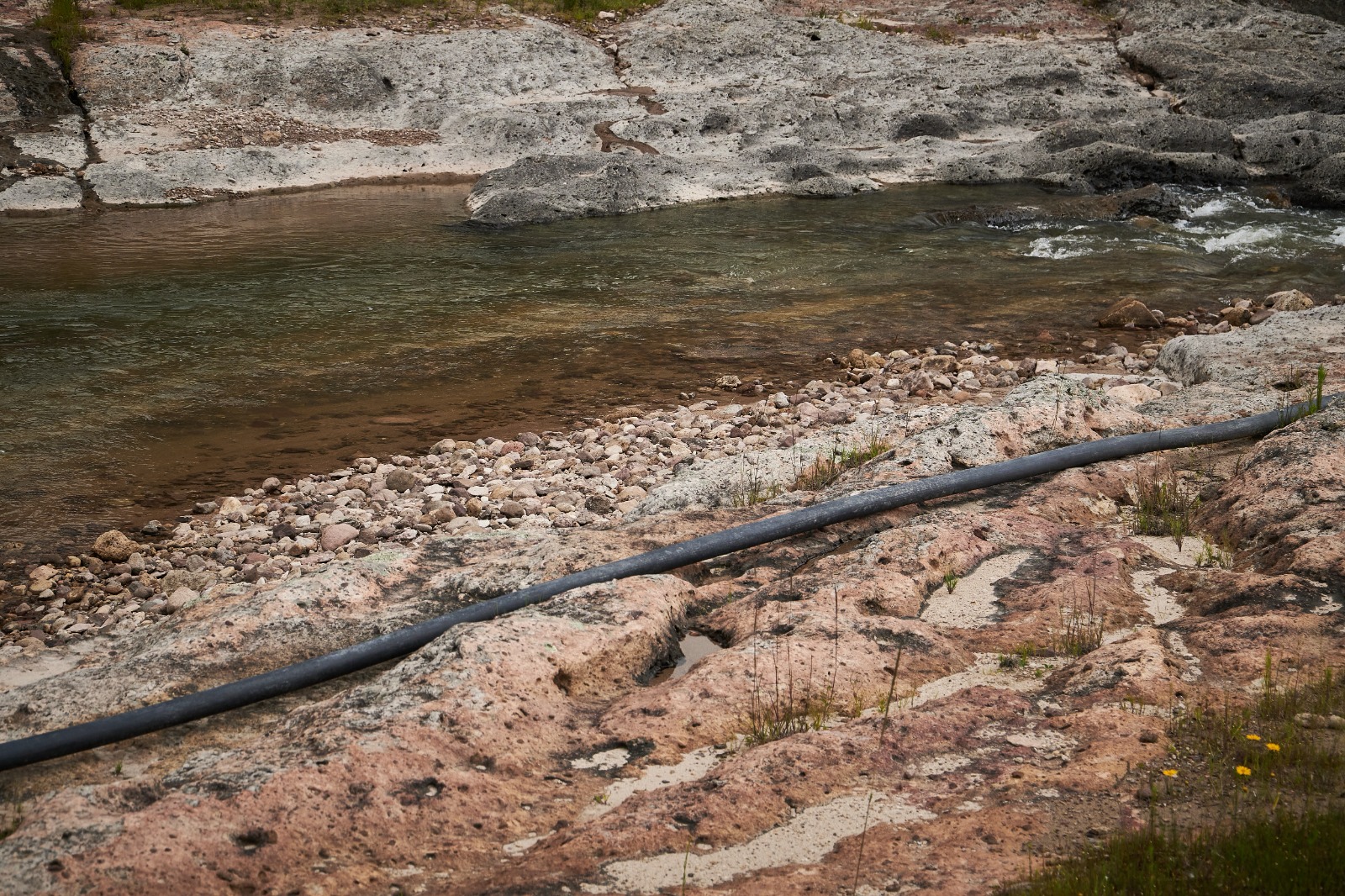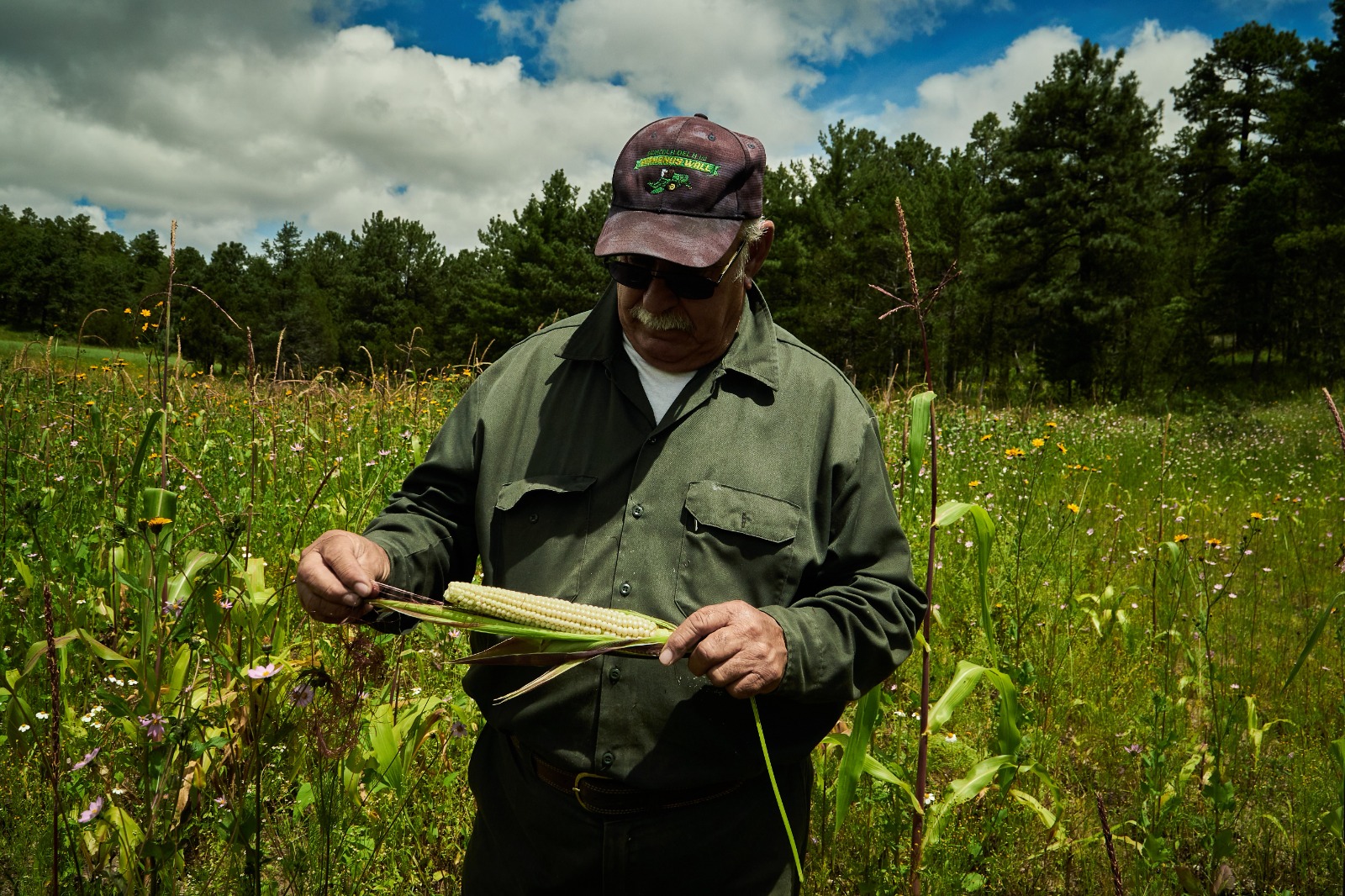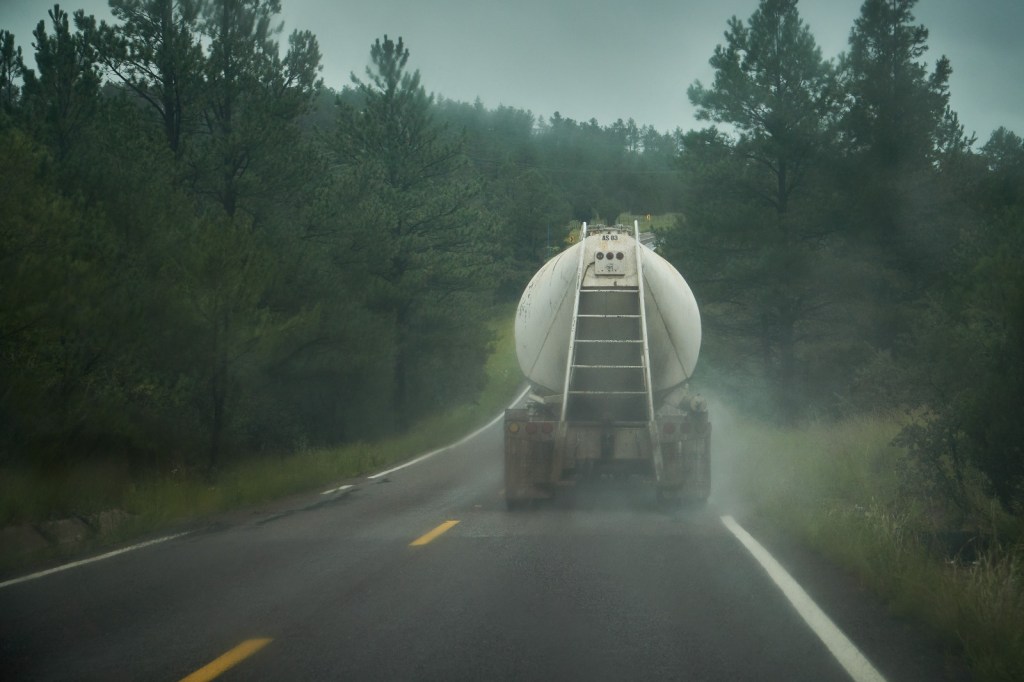URIQUE, Mexico — Deep inside a canyon in the mountains of Chihuahua, Mexico—a place that’s accessible only by mule or on foot—locals haven’t seen this river full for over eight years. And now, the waterway is the property of the Sinaloa Cartel.
“Here, everything has an owner,” said a mid-level Sinaloa Cartel commander for the region, who asked to be called “El Señor.” “Rivers, creeks, lakes… everything, and especially water.”
Videos by VICE
During what Mexican authorities called the worst drought in the country’s history last year, thousands of local farmers—many of them Indigenous Raramuri people—lost their crops. But the Sinaloa Cartel saw a new business opportunity: the control and distribution of water.
Using water trucks, pipelines, and an army of lookouts, the cartel is siphoning water from lakes, rivers, and creeks in the mountains of the northern state of Chihuahua. The business model is twofold: The cartel wants to keep its own weed and poppy fields irrigated, and it wants to be the broker that supplies water to farmers, hotels, and other local businesses that have been left dry.
“Water is now a valuable asset for us, and as it becomes more scarce, the more we will fight to make sure we have enough,” El Señor said.

Water is the new black market throughout northern Mexico as climate change is keeping the seasonal rain away.
In July, armed men hijacked a truck carrying 1,600 containers of water, with a bit over 10,000 liters, while traveling through the Guadalupe municipality in the northern state of Nuevo Leon, according to authorities.
Guadalupe is facing shortages that force residents to be without water for as long as two months. But the rural regions of Chihuahua have been probably some of the worst hit by the drought.
In the summer of 2021, Chihuahua state declared that 100 percent of the crops in the state were “completely lost” for the first time in history as a consequence of climate change, leaving more than 22,000 local farmers in extreme poverty.
This year, however, the rain came pouring down, just recently. The Sierra Madre Occidental used to see the seasonal showers starting in late June and all through July, but this year the rains started in September.

Local agronomist Ramón Campoy, who for the last 45 years has been helping local farmers to sow, fertilize, and harvest their land around the Urique municipality, said that although these showers will bring momentary aid to the crops, it will not be enough to fill the state’s dry reservoirs.
“This is the first heavy rain we’ve gotten in more than 8 or 10 years,” he said as we walked across a golden cornfield owned by a local Raramuri farmer. The ground is still damp from the morning shower, and the crops, taller than us, bend as Campoy makes his way through them. At the very back of the field stands a small wooden barn where the farmer stores the corn for the rest of the year.
“All this corn is fully grown, and it will last to give something to eat to these people for the rest of the year. But when winter is over, we will be at risk again.”
The cartel’s clandestine marijuana and opium poppy fields, however, were never at risk.
Last year, as the drought continued, the cartel acquired water trucks and bought hundreds of miles of polyduct, a black plastic pipeline used to channel water from one place to another, to pump what water there was out of creeks and lakes toward hidden crop fields, the cartel operative and local farmers said.

“We started seeing truck after truck carrying polyduct on the highways since last summer, but we didn’t know what for. We thought they were for the construction of the new airport,” Alberto Ramírez, a local Indigenous Raramuri farmer, told VICE World News.
The clandestine weed field VICE World News visited is several kilometers down a canyon, making it hard for authorities to find it from above or to raid it before everyone can escape. The land is the size of half a football field, on a plane surrounded by huge rocks. The pungent odor of the weed mixes with the smell of pine trees, and the sound of a small river nearby echoes on the rock walls.
Getting to the field required a two-hour off-road drive followed by 40 minutes of walking.
As we go deeper into the full-grown weed plants, several Raramuri people pass us without acknowledging the weed plantation, or the armed men around us.
It’s not uncommon to have locals pass by his crops, said El Señor, and his cartel guards, looking out from the top of a hill, follow the steps of everyone who walks by this land.
“This [water] system is relatively new,” El Señor said. “But it’s working.
“Right now we are not pumping [water] because we are getting showers, but maybe next summer it will be operating again.”
Around the field, a black plastic pipeline is stapled to the pine trees. The pipe is connected to a small, motorized pump sucking water from a small creek that was almost completely dry until recent showers replenished it.
“That creek is one of the new formations. It was dry last year, and even then we took water out from a bigger lake a bit further from here,” said the cartel operative.

Farmers like Ramírez can’t afford to buy the materials needed to transport water to their land, and even if they could, the cartel has established lookouts all around the main bodies of water as it becomes a major stream of income for them.
“We can’t go to the lake or the creek to gather water without asking for permission [from the cartel],” Ramírez said.
Chihuahua mostly produces chiles, tomatoes, and apples for export, bringing in over $2.9 billion in revenue each year, according to official statistics. The region of the Sierra Madre Occidental is best known for its corn and bean production, mostly for local consumption.
Last year, during the drought’s peak, many of the area’s farmers had to leave their crops to work in the local fruit factories for a daily wage of less than $2, according to locals. These factories are for the most part owned by national and international corporations that can afford wells and advanced irrigation systems to keep their crops alive for several years during a drought. More than 90 percent of production is exported to the U.S.
“We are not used to this, to working in factories for money,” Ramírez said. “We harvest what we eat or exchange with other farmers, and we only sell what we are not going to eat that year.”
Many others were recruited voluntarily to work on clandestine weed and poppy fields like the one run by El Señor. Others resorted to working as drug mules, carrying weed loads through the desert and into the U.S. to make an income to feed their families, according to local farmers.
The cartel is even claiming to be the source of water used in local hotels and restaurants.
“Ask yourself, how come that in the middle of a drought, when most of the people didn’t have water in their houses, you could still take a 20-minute shower in a hotel room?” he said.
During the summer, while the drought was at its worst, the Urique municipality, home to the tourist destination of Creel, implemented water rationing to homes and businesses, but allegedly most of the hotels sourced water from the cartel to keep their business afloat.

The region of the Sierra Madre Occidental is composed mostly of “seasonal land,” which means there’s no need for wells or water pipes because the sowing season starts with the rain. Or at least, it did before the drought.
For authorities to ease the problem of water scarcity, they’d have to bring water trucks from the nearest dam. But the biggest lakes that hold water for long periods of time even during hot summers are protected by law, and extracting water from them is illegal. All of this leaves the authorities with their hands tied.
But the cartel version of events could explain why the Arareco Lake, one of the oldest and most important in this region, is failing to reach a healthy water level despite the recent showers.
Although not openly pointing fingers at the cartel, locals like Campoy and Ramírez believe that “someone” could be illegally extracting water from the lake.
“Look at the level in the rocks: It is still very low and it looks like it’s not filling up,” Campoy said. “Some people say it’s because the water is going underground through a crack, but we really don’t know what is happening.”
In June, Chihuahua state authorities started a crusade against “aguachicoleo,” the local term for water theft. So far, it has closed more than 3,000 clandestine water stations that were siphoning water from government water pipelines, but none of them inside the Sierra Madre Occidental.
Human rights activists have warned against the increasing violence around the theft of natural resources such as water, wood, and underground minerals all over Mexico. From 2019 to 2022 at least 58 environmentalists have been killed, according to official figures.

“The wars between armed groups are now for water, and there are people trying to protect their land and their water, and they have died, not only here in Chihuahua but in several other places,” said Javier Ávila, a Jesuit priest and director of a human rights non-profit in the Sierra Tarahumara.
“This will not end soon. I really believe this will get even worse.”
Ramírez, like thousands of other farmers in northern Mexico, worries what may happen next year. But he’s happy about the rain.
“The rain might have come a bit late, but it is always better late than never,” he said. “Next year we’ll see. If the drought comes again, we will not have any water; we will have to go to work on something else and leave our land again.”
El Señor, on the other hand, isn’t worried about the future of his cartel crops. As we head out of his weed field as the sun goes down, he orders one of his people to load “one last water truck” for the day from the nearby creek.
Within a few minutes, a couple of his men jump into an unregistered water truck and head toward the creek.
“You never know when it is going to stop raining again,” he said. “And we can’t take that risk.”




